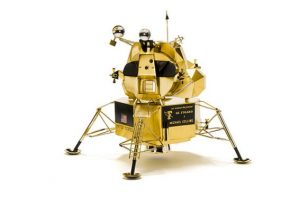There were some interesting news stories related to the exploration of space over the last month reaching from right here on Earth to the very limits of the observable Universe. I’ll start with some news that is both shocking and saddening about the legacy of the first man to walk on the Moon, Neil Armstrong.
In Armstrong’s hometown of Wapakoneta, Ohio there is the Neil Armstrong Air and Space museum. The museum was built by the State of Ohio as a place to honor Armstrong’s achievements and display for the public some of artifacts and tributes that were bestowed on the astronaut during his career. I’ve been there, it’s a wonderful little museum where you can learn about, or remember as the case may be, the early days of space exploration. I highly recommend it if you’re anywhere near northwestern Ohio.
Now on the night of Friday the 31st of July the museum was broken into and robbed by what authorities believe were three or four men. A number of exhibits were stolen including rare medals and coins but the most valuable item that was taken was a solid gold miniature model of the Lunar Module Eagle presented to Armstrong upon his return to Earth after his Moon landing.
Local police hope to recover the stolen items but right now they have no idea who the burglars were. The scariest thing is that the gold LM model could be melted down for the gold so that no one would ever know what it once was. Anyway it’s a sorry comment on our time that money and greed should in any degree tarnish the legacy of the greatest achievement in human history. The photo below shows Michael Collins’s model of the stolen LM replica.

My second story concerns our picture of the entire observable Universe and how much we’ve learned about it. A new study called the ‘Dark Energy Survey’ (DES) has released some very detailed results of the structure and distribution of matter in the Universe along with how the structure and distribution have changed over the past seven billion years.
The DES team employed a technique called gravitational lensing, a phenomenon first predicted in Einstein’s General Theory where the light from a distant object can be bent by the gravitational field of a closer object. This technique can be used to measure the mass of the closer object by how much it bends the light of the distant object. Using this technique 26 million galaxies, that’s right 26 million galaxies, had their mass measured allowing a map to be made of the mass distribution in a large section of the Universe, see photo below.

In previous posts (25Sept16 and 3Dec16) I have mentioned the Cosmic Microwave Background (CMB), the leftover heat of the Big Bang which gives us a ‘baby picture’ of our Universe about 380,000 years after the Big Bang. So with the addition of the new DES study we can now test our theoretical models of cosmic evolution. In other words, taking the CMB measurements as the initial conditions do our models give us the kind of Universe we see in the DES?
It turns out that the simplest model; known as Lambda-Cold Dark Matter (λ-CDM) is still an excellent fit. In the model the Dark Energy accelerating the expansion of the Universe is just a constant term (Einstein used the Greek letter λ in his equations) and the Dark Matter we can measure only by its gravity it composed of heavy particles of some kind.
This is a rather strange state of affairs. We don’t know what 95% of the Universe is (Dark Energy, Dark Matter) but when it comes to predicting how it behaves we’re spot on!
Finally, you may have heard that NASA has a job opening for a new Planetary Protection Officer. No, we’re not talking about fighting off the aliens, at least not with a ray gun. NASA has had a Planetary Protection Officer ever since the days of Apollo when there was a very real concern that Lunar microbes might be able to hitch a ride to Earth with our astronauts.
Today most of the Planetary Protection Officer’s job actually deals with protecting other planets, such as making certain that Earth bacteria don’t use one of our Mars Rovers to contaminate the planet before we can discover whether or not life originated there. (Imagine the first astronauts on Mars discover life!!!! Oh wait; it’s just a staphylococcus infection.)
Now if you think Planetary Protection Officer sounds like a fun job, well nine-year-old Jack Davis of New Jersey thought so to. He applied for the job in a hand written note which includes as a qualification “My sister thinks I’m an alien”. Anyway, Jack got a nice reply from NASA’s Director of Planetary Science Doctor James Green telling him to study hard and one day he can work for NASA. Hopefully one day he will.
